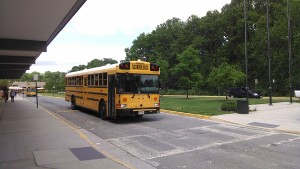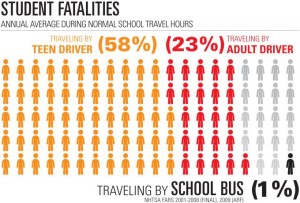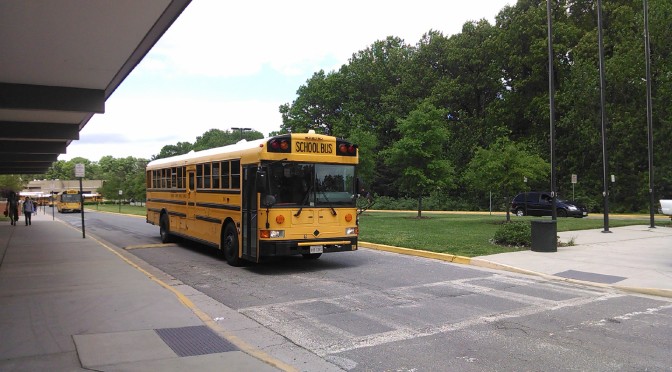
One of the questions I frequently get from parents involves school transportation safety. Parents usually ask me whether it’s better to use one way or another, and if the “best” way changes with the age of their children.
I understand the concern. I have kids of my own, and think about their safety and development every day. We send our kids to school through a variety of ways, although the two most common ways involve school buses and driving them, followed by walking and bicycling. However we do it, we want to make sure our kids are protected. But what’s the safest way?
The answer is the school bus. When it comes to getting your child to and from his or her school, there isn’t a safer way, statistically speaking, than by bus. Let’s dive into why.
How much safer are school buses than teens driving themselves or parents driving them?

This chart from School Bus Facts lays out the case clearly for students traveling by school bus instead of with teen drivers or even parents. For every 100 students who died traveling to school in a given year, more than 58 were either driving themselves or riding with fellow teens. Another 23 were killed while being transported by parents. Another 18 died through other causes (e.g., being hit as pedestrians or cyclists, as motorcycle occupants, and in other types of vehicles). Only one was likely to die while traveling by school bus.
To put it another way, it’s more than 50 times safer for students to travel by bus than by driving themselves or with other teens, and it’s more than 20 times safer for students to travel by bus than with their own parents.
This is huge.
However, the dramatic safety differences become clearer when we put some actual numbers into the statistics. Per an NHTSA Safety In Numbers newsletter, close to 500 (490) students between 5 and 18 die annually in passenger vehicles (e.g., cars, SUVs, minivans, etc) during hours of school-related travel (i.e., 6-9 AM and 2-5 PM), and 74% of those fatalities involve teen drivers. An additional 100 children between 5 and 18 will die each year while walking or cycling to school (75 pedestrians and 21 bicyclists).
How many school-age children will die each year while riding school buses, in contrast?
Only 4. Far less than 100, and far, far less than 500.
What makes school buses so much safer than cars, even when parents drive?
School buses are safer than cars, whether those cars are driven by teenagers or by parents, because school buses are designed with safety in mind. They’re larger, heavier, and more structurally sound than passenger vehicles. They need to meet far more federal safety standards than passenger vehicles, including the use of overhead flashing lights, which increase visibility, and stop arms to stop traffic when loading and unloading students.
Additionally, school buses have closely spaced seats that absorb energy to protect students in collisions; these seats keep students safe without seat belts by cushioning them and keeping them close to where they are seated. The process is commonly called compartmentalization, and it works well in comparison with the much greater mass of school buses, which results in much lower crash forces.
Beyond these factors, school bus drivers are highly trained and pay far more attention to the task of driving than the average driver. They are also more likely to follow traffic rules and regulations (including speed limits and stop signs) due to being profesional drivers.
Why are school buses safer than walking or bicycling to school?
School-age children are 5x less likely to die (4 vs 21) while riding the bus than while bicycling to school, and close to 20x less likely to die (4 vs 75) while riding the bus than while walking to school. Why is this?
Unfortunately, it comes down to the prevalence of vehicles throughout the country, and the massive protection offered by a school bus compared to the complete lack of protection present when walking or cycling. I’m a huge fan of walking and cycling to get places, but in a country with lots of passenger vehicles, it does involve risk. These pedestrians and cyclists were killed by other vehicles; when those vehicles crash into school buses, the occupants in the school buses almost always survive.
What do I do if we live too close to school to take the bus, or if it simply isn’t an option for us? Do we walk, cycle, or drive?
If you can’t use a school bus to get your child to school (perhaps due to attending a private school, for example, or due to conflicting schedules), then I’d encourage you to make the safest choice for your family. If you have a safe path for walking or cycling, this would be my preference, as it minimizes the risk of road traffic and contact with thoughtless motor vehicle operators. If walking or cycling isn’t an option, then I’d drive my kids. The least preferred option, by far, would be to have my kids drive themselves; this is where most school-age child fatalities occur, year after year.
 If you find my information on best practices in car and car seat safety helpful, you can do your shopping through this Amazon link. Canadians can shop here for Canadian purchases. Have a question or want to discuss best practices? Join us in the forums!
If you find my information on best practices in car and car seat safety helpful, you can do your shopping through this Amazon link. Canadians can shop here for Canadian purchases. Have a question or want to discuss best practices? Join us in the forums!

